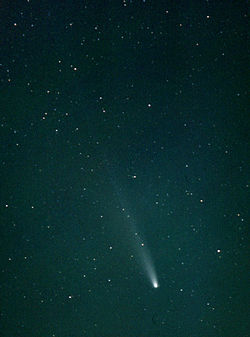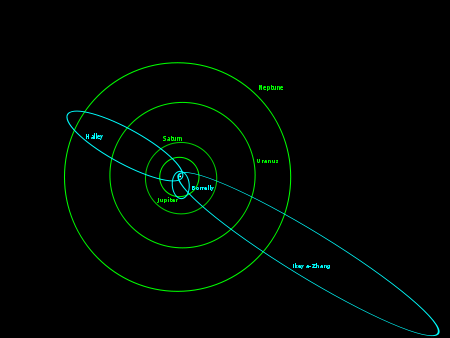- 153P/Ikeya–Zhang
-
153P/Ikeya-Zhang 
Ikeya-Zhang on April 1, 2002Discovery Discovered by: Kaoru Ikeya, Zhang Daqing Discovery date: February 1, 2002 Alternate designations: C/2002 C1 Orbital characteristics A Epoch: October 13, 2002 Aphelion distance: 101.9200 AU Perihelion distance: 0.507141 AU Semi-major axis: 51.2136 AU Eccentricity: 0.990098 Orbital period: 366.5101 yr[1] Inclination: 28.1199° Last perihelion: March 18, 2002[1]
January 29, 1661[2]Next perihelion: September 1, 2362[2] Comet Ikeya-Zhang (Chinese, Japanese: 池谷-張彗星, officially designated 153P/Ikeya–Zhang) is a comet discovered independently by two astronomers from Japan and China in 2002.
On February 1, 2002, Chinese astronomer Zhang Daqing from Kaifeng discovered a new comet in the constellation Cetus, and reported it to the IAU. He found that Japanese astronomer Kaoru Ikeya had discovered it earlier than he had, as the time of sunset is earlier than China. According to tradition, since they discovered the new comet independently, the comet was named after both of them. The comet was initially designated as C/2002 C1 (Ikeya-Zhang).
The comet passed perihelion on March 18, 2002, and with apparent magnitude 3.5, it became the brightest comet since 1997. The orbital period was calculated as 366.51 years. A bright comet had been recorded by Chinese astronomers in 1661, 341 years earlier, and confirmed comet Ikeya-Zhang was the return of the 1661 comet recorded by the astronomers. The permanent designation "153P" was given to the comet, and it is the periodic comet with the longest known orbital period.
 The orbits of three periodic comets, Halley, Borrelly and Ikeya-Zhang, set against the orbits of the outer planets. Ikeya-Zhang is to the right.
The orbits of three periodic comets, Halley, Borrelly and Ikeya-Zhang, set against the orbits of the outer planets. Ikeya-Zhang is to the right.
Footnotes
- ^ a b "JPL Small-Body Database Browser: 153P/Ikeya-Zhang". Jet Propulsion Laboratory. 2002-10-02 last obs (arc 341.6 yr). http://ssd.jpl.nasa.gov/sbdb.cgi?sstr=153P. Retrieved 2011-04-20.
- ^ a b Syuichi Nakano (2002-08-13). "153P/Ikeya-Zhang". OAA Computing and Minor Planet Sections. http://www.oaa.gr.jp/~oaacs/nk/nk865.htm. Retrieved 2009-10-04.
External links
- Orbital simulation from JPL (Java) / Horizons Ephemeris
- 153P/Ikeya-Zhang (2002)
Periodic comets (by number) Previous
152P/Helin-Lawrence153P/Ikeya–Zhang Next
154P/BrewingtonCategories:- Comets
- Comet stubs
Wikimedia Foundation. 2010.
